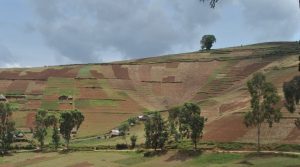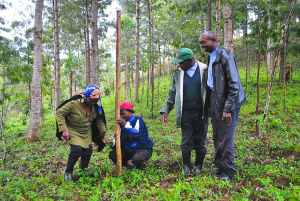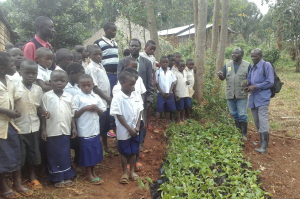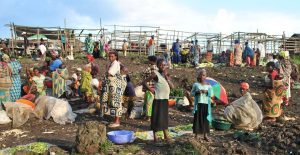
By Joan Baxter, originally published at ICRAF’s Agroforestry World Blog
It’s a tall order solving the myriad developmental challenges in North Kivu Province in the Democratic Republic of Congo (DRC), where years of conflict have caused so much human suffering and environmental upheaval. Today the province is plagued by rampant deforestation and land degradation and hence low agricultural production, while also having to cope with high population densities and urbanization rates.
These can all be tackled, according to the provincial Minister of Agriculture, Fisheries, Livestock and Rural Development, Christophe Ndibeshe Byemero, if agroforestry forms the basis for a strategy for sustainable agricultural development.
The Minister was speaking at a workshop held earlier this year in the provincial capital, Goma, to examine ways to develop and expand agroforestry in the area. Organized by the World Agroforestry Centre (ICRAF) and the World Wide Fund for Nature (WWF). The workshop brought together 46 participants from a wide array of local, national and international organizations, with strong representation from civil society groups from many parts of the Province. It marked the culmination of three years of agroforestry research in development in the region that aimed to develop a socially inclusive strategy for scaling up agroforestry and tree diversity.
According to Thierry Lusenge of WWF in the DRC, the time is now ripe to recognize the importance of agroforestry in helping populations adapt to and mitigate climate change, reduce deforestation and improve food security.
Looking back and learning…

The workshop was the last of three held in the region as part of the project, Forests and Climate Change in the Congo (FCCC), funded by the European Union and led by the Center for International Forestry Research (CIFOR). The agroforestry component of the FCCC project, led by ICRAF, was a part of the CGIAR Research Program on Forests, Trees and Agroforestry.
It built on the knowledge gleaned from previous workshops and acquired through interviews with diverse groups in the area, bringing together participants from four territories in North Kivu. Participants looked back at their agroforestry accomplishments over the past three years and at lessons learned from the diverse projects they’d been part of.
Deogratias Mumberi Kyalwahi of the women’s conservation group, Femmes Actives pour la Conservation de la Faune et de la Flore (FACF), presented findings from a project to establish agroforestry and improve agricultural production around the city of Beni, as a way of reducing human encroachment in the neighbouring Virunga National Park.
Virunga is a World Heritage site that boasts 2,000 plant species as well as endangered animal species including the iconic mountain gorilla.
Fataki Baloti, representing the youth conservation group Jeunes pour des Ecosystèmes décents et l’Assainissement de la Nature (JEAN), spoke of their work to achieve food security and combat malnutrition, by integrating livestock production and agroforestry, which improved relations between local people and the Congolese wildlife authority, Institut Congolais pour la Conservation de la Nature (ICCN), which is responsible for the national park.

Improved human welfare around the park, with more – and more diverse – tree cover that provides income, environmental services and contributes to food security, is critical for preserving the park and for peaceful, constructive interactions between nature conservationists and local people.
Other participants highlighted peri-urban agroforestry projects around Goma to combat poverty and malnutrition – introducing shade trees in coffee systems in the Beni territory, trees for improving soils in Rutshuru territory, and promoting raising and selling tree seedlings in Lubero and Kirumba towns.
Emilie Smith Dumont of ICRAF explained that agroforestry “while not a panacea, can contribute to making livelihoods and landscapes more sustainable”. She emphasized that it involves many different practices suitable for different people and places, such as planting trees on contour slopes, establishing windbreaks for pastures or fodder banks, fruit trees in orchards and homegardens. These include diverse tree species adapted to different environments and to specific needs of the farmers themselves.
Removing barriers to adoption

Participants agreed that while significant progress has been made in collecting information on promising native tree species for agroforestry in the region, and in developing practical tools, including a technical agroforestry guide that helps people to put agroforestry knowledge into practice, some key changes in policy and practise are needed for further agroforestry expansion and development in the region.
They identified seven major issues that need to be addressed in an integrated way – gender, markets and commercialization, governance, availability of and access to quality tree planting material, improving agroforestry know-how given low literacy rates, threats such as fire and pests, and, cultural realities.
Gender and tenure at the fore
Women farmers trade at the evening market in Kitchanga, Masisi, North-Kivu, after a day in the field. Many members of the community are internally displaced and farming marginal land with no tenure security.. Photo by E Smith Dumont.
Two issues – tenure and gender – emerged as perhaps the most pressing constraints. On theissue of gender, Vea Kaghoma of the league of women’s smallholder organizations in DRC, Ligue des Organisations des Femmes Paysannes du Congo, was adamant and unequivocal. Speaking at the closing of the workshop, she said women, who constitute the majority of farmers and traders, should be at the heart of all agroforestry efforts in North Kivu and that the participation of women’s organizations is indispensable if these efforts are going to succeed.

Emilie Smith Dumont of ICRAF concurs. “Without secure land tenure, especially for women, it is difficult to progress to the next step of really scaling up agroforestry in DRC,” she says. Farmers cannot begin to envisage making long-term investments in their land health or in tree planting if they do not have secure access to land.
Spreading the word
Dumont Smith is greatly encouraged by the momentum that emerged from the workshops, and at on-going work by participants to put into practise what they have learned over the past three years.
Wilson Kasereka Kabwana, president of a group to support and consolidate peace and development in North Kivu (Programme d’Appui à la Consolidation de la Paix et le Développement or PACOPAD), reports that his group has now developed a nursery for several agroforestry species. They work with local communities and schools to spread the word on their value for nutrition, as medicine or for the environmental services they provide.
Mone Van Geit, Project Manager International Programs, WWF Belgium, says the idea is to continue to cultivate the strong partnerships that were forged during the FCCC project, with strategies that will permit WWF to support local communities in diversifying species and practices to address a broader range of stakeholder needs. When it comes to energy woodlots, which she says remain a key priority for WWF around the park, diversification and inclusion of native species will be high on the agenda. This will require innovative approaches to test mechanisms for incentives and trials for species carefully designed and evaluated.
Fergus Sinclair who leads the systems domain at ICRAF said he hopes that ICRAF, WWF, their partners in DRC, and new ones with an interest in tenure, gender and markets, will be able to secure support for multidisciplinary projects that will build on the foundation laid by FCCC and act as the launch pad for agroforestry development in the region.
In the words of the provincial minister, Christophe Ndibeshe Byemero, in ten years, if partners continue to work together, North Kivu could become a veritable “model of agroforestry”.
For more information on this work, please contact Emilie Smith Dumont: e.smith@cgiar.org
Workshop report: http://www.worldagroforestry.org/output/north-kivu-report-workshop-drc
More about ICRAF’s “research in development” approach can be found in these two blogs: One small change of words – a giant leap in effectiveness! and For every tree a reason — research “in” rather than “for” agroforestry development
More about the FCCC project can be found in this blog: Outside a national park, agroforestry helping to save forests inside the park.
More about the technical agroforestry guide developed for North Kivu as part of the FCCC project: Beyond eucalyptus woodlots: what’s on the agroforestry menu for communities around Virunga? The technical guide (available in French only) is available here: Guide technique d’agroforesterie pour la selection de la gestion des arbres au Nord-Kivu











